Aerial Photography Technology, Old and New
By: Mitch Bloomquist and James Baty | Concrete Foundations Association
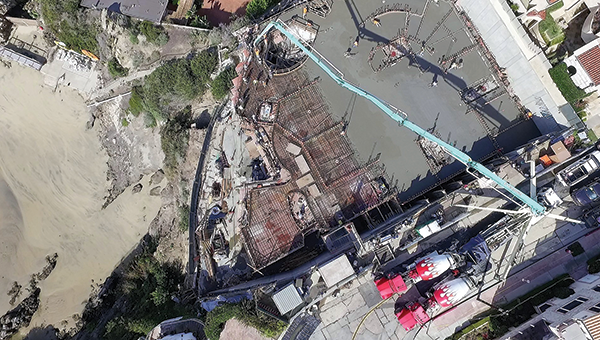
Drone image capturing the Aerie Residence, 2017 Overall Grand Project of the Year from the Concrete Foundations Association. Photo courtesy of Ekedal Concrete, Inc., Newport Beach, CA.
Drones continue to be a very hot topic these days. Whether you attend World of Concrete, pay attention to the news media or pay attention to the photos posted throughout social media, the age of drones is here. The news offers a wide variety of perspectives, from a viral image captured during the royal wedding of Prince Harry and Meghan Markle to hijacked drones on the 2014 season of the hit TV show 24, to Amazon announcing plans to use drones to execute same-day deliveries. The technology is making its way into more and more hands. In the construction industry, some contractors are beginning to experiment with drones and aerial photography. This fascination with the bird’s eye view is nothing new, though. People have been going to the extreme to capture these images for over one hundred years.
According to the Professional Aerial Photographers Association (PAPA), French photographer and balloonist, Gaspard-Félix Tournachon patented the idea of using aerial photographs in mapmaking and surveying in 1855, and he took the first known aerial photograph in 1858. The photo was a view of the French village of Petit-Becetre taken from a tethered hot-air balloon, 80 meters above the ground. Technology at the time required a complete darkroom to be carried in the basket of the balloon.
As it often does, technology changed quickly. In addition to hot-air balloons, early pioneers employed rockets, kites and even pigeons to carry their equipment up into the air. English meteorologist E. D. Archibald was among the first to take successful photographs from kites in 1882, but George R. Lawrence took perhaps the most famous photograph in 1906. Using a heavy, large-format camera attached to a string of 17 kites flying 2,000 feet above the city of San Francisco, Lawrence documented the devastation after the 1906 earthquake and fire that destroyed over 80 percent of the city.
Dr. Julius Neubronner was a German photographer reported to have invented a breast harness for pigeons. In 1907, his harness was capable of holding a camera with two lenses. Rather than relying on the pigeon to snap the shutter, Dr. Neubronner devised his invention to be inflated with air. As the pigeon flew, the air would slowly leak, and once all the air was gone, a piston-actuated shutter would move and take the image. Read more on Neubronner.
Wilbur Wright captured the first image taken from an airplane in 1909, and aerial photography soon replaced sketching and drawing by aerial observers during World War I. Following the war, the aerial camera was turned to non-military purposes and quickly proved to be a successful commercial venture.
Today, airplanes are still used regularly for aerial photography and are often employed by contractors to capture progress shots of projects throughout the construction process.
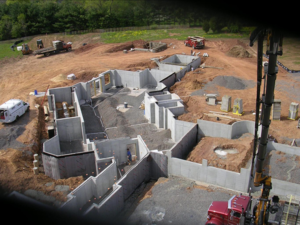
Not to be outdone, CFA members have creatively employed equipment to take photos of residential foundations for years. While knuckleboom cranes are not likely “OSHA-approved”, for aerial manlifts, the form basket became a popular “cage” to send someone high in the air to capture the impressive and complex geometry.
Photo caption: Randy Groome contributed great aerial photos, taken for projects his
company submitted to the CFA Projects of the Year, using a knuckleboom crane and form basket with lanyard. Photo courtesy of Balmer Brothers Concrete Work, formerly of Akron, PA.
Over the last couple of years, participants in the CFA’s annual Projects of the Year
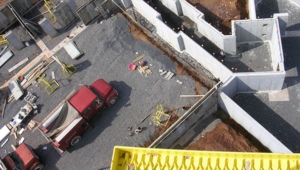
competition have been proving the value of the new photography option that is quickly gaining in popularity: drone photography. According to Dave Sheppard with SCW Footings & Foundations Inc. of Salt Lake City, Utah, there is much to be gained from acquiring a drone for your business.
“Technology is an ever-changing and ever-advancing thing in today’s world,” states Sheppard. “The construction industry is no exception to that fact. From the engineering and design behind the projects to the application and execution of them, technology is always at the forefront of a
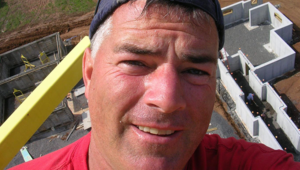
Randy Groome contributed great aerial photos, taken for projects his company submitted to the CFA Projects of the Year, using a knuckleboom crane and form basket with lanyard. Photo courtesy of Balmer Brothers Concrete Work, formerly of Akron, PA.
successful project. We at SCW Footings & Foundations use complex AutoCAD software to draw our foundations. We use state-of-the-art robotic layout machines to properly place our foundations. And we use the newest and most effective tools and machines to build our foundations to the best possible standard.”
The most recent drone purchased by SCW is the DJI Mavic Pro. “This drone is the state-of-the-art technology available to the public,” states Sheppard. He says the Mavic Pro is nimble, agile and rock steady. “Along with the flight capabilities of the drone, it comes standard with a fully controllable 4K camera for still pictures and video. This allows us to get any and all angles of our work photographed in order to showcase our finished product. We are very pleased that we chose to purchase a drone. The Mavic Pro sells for under $1,000 and requires little to no maintenance/upkeep. It is well worth the cost, and we would recommend it to any and all contractors looking to further their advertising game.”
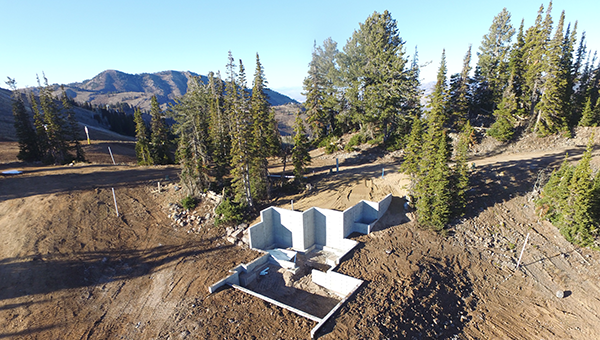
The drone photography for this “under 2,000 square feet” and remote project contributed to the award recognition it received in 2017. Photo courtesy of SCW Footings & Foundations Inc., Salt Lake City, Utah.
According to Shepherd, the drones prove themselves over and over again as people discover new applications and find ways to save time and improve safety. Drones have highly influenced photography. These photos not only bring striking shots to present and archive finished work, but also their photos are used to investigate quality control and inspect their installations. “We pride ourselves in building and pouring the most difficult and impressive residential foundations in the industry,” Sheppard says. “In any market nowadays, being able to visually showcase a product is key. If it’s attractive, odds are people will want to buy it. Footings and foundations get thrown on the back burner fairly often when it comes to the overall glamour of a project. We’re doing our best to change that. This is where drones come in. The best way to see a bunch of poured concrete in a hole is to get above it.”
Flying over sites prior to bidding a job allows them to document and study existing conditions, including access to the site. President of SCW, Kirby Justesen, offered ways they have expanded the use of drones. “On a project late last year, we sent the drone into the site to see what kind of access we might have. This provided us with the support necessary to instruct the owner that the site wasn’t buildable for what he wanted to accomplish. We are constantly pursuing ways of making us more efficient and effective at what we do.”
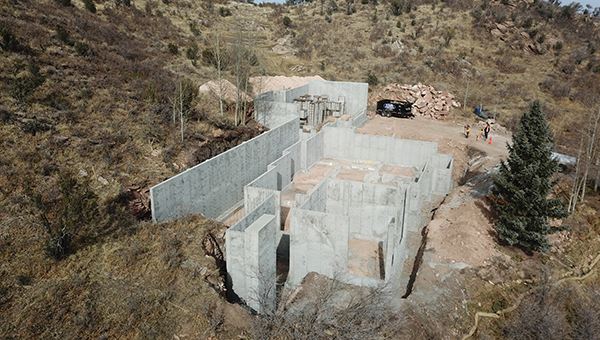
Whether for inspections or final photographic records, the drone takes images that are much more difficult or even impossible to capture with traditional means, such as this mountain foundation. Photo courtesy of SCW Footings & Foundations Inc., Salt Lake City, Utah.
Herbert Construction Co. of Marietta, Georgia also has begun using drone technology in their business. “We used to hire an aerial photographer in an airplane for our really big projects,” said Doug Herbert, the company’s president. He is convinced those aerial photos helped his company win some of their CFA Project of the Year awards. Those same photos are also used heavily in their marketing and sales pieces. The company bought a drone late last year and they are beginning to use it to take photos and videos. “Because of the cost of the aerial photographer, we didn’t get photos on a lot of really interesting and complex projects that we’ve done. We finally decided to get a drone and use it on a lot more of our projects.” Doug sees video footage taken by the drone to be even more valuable than the photos. He explained, “Video is the most effective marketing media right now. We plan to utilize the videos from our drone in all of our marketing.” This will include videos on their website and social media, sales videos shown and sent to prospects, and videos sent to customers showing their own project’s foundations.

Photo courtesy of Herbert Construction Company, Marietta, Georgia.
While law governing the operation of these remote-controlled pilotless aircraft will surely become more defined, there are countless conditions and spaces where flying a drone is more practical than using a full-sized helicopter or airplane. Perhaps, though, some may prefer to not get involved with the FAA registration process and maintaining authorization, and not deal with training an employee(s) on the regulated parameters encompassing drone technology.
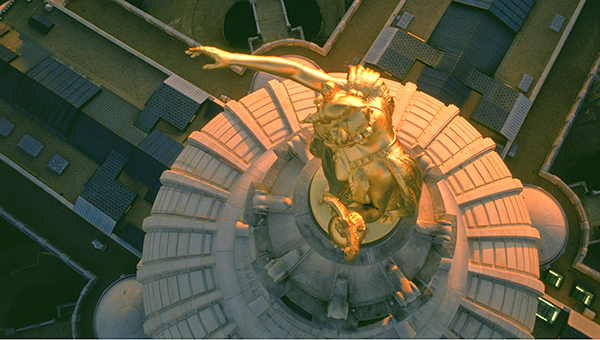
“A Badger On Her Head”, published in Hanging by a Thread: A Kite’s View of Wisconsin (2006). Photo courtesy of Craig Wilson, Kite Aerial Photography, Madison, Wisconsin.
Still, more options exist. Craig Wilson, from Madison, Wisconsin, specializes in kite aerial photography. His work has been published in a book, Hanging by a Thread: A Kite’s View of Wisconsin (2006). Published by Itchy Cat Press, the Blue Mounds imprint of Flying Fish Graphics, the book includes 140 color plates on 132 pages. The majority of the images focus on Madison, bringing new perspectives to familiar settings. A newer book titled A little More Line: A Kite’s View of Wisconsin and Beyond (2012) is also available.

A crowd close-up, published in the book “A Little More Line: A Kite’s View of Wisconsin and Beyond (2012). Photo courtesy of Craig Wilson, Kite Aerial Photography, Madison, Wisconsin
David Medaris at Isthmus, Madison, Wisconsin’s alternative news media, wrote, “Where satellite images are static, remote and gridlike in composition, Wilson’s kite cam affords a more human-scale acuity, full of color and life and artistic intent that is beyond the ability of even low-flying surveillance craft.”
Wilson’s camera is mounted to a kind of homemade armature that hangs a good distance below the kite itself, which flies smoothly high up in the air. Surprisingly, very little wind is needed to get the kite and equipment up into the air, according to Wilson.
Some of Wilson’s most impressive images are his aerial close ups. Ron McCrea wrote in Capitol Times, “It’s unusual because images from a kite often get oddly close to crowds and buildings at a medium altitude, using normal lenses that capture detail and lifelike effects that a long-lens photo taken from a helicopter simply can’t replicate without distortion.”
A CFA member, Hottmann Construction of Madison, Wisconsin can corroborate the effectiveness of kite photography. Perhaps you will recall their astounding Grand Project of the Year from 2014 with the serpentine foundation. “Located here in the Heartland, farming is a large portion of our industry,” states Mike Thole, vice president for Hottman. “Every farm I visit seems to have an aerial picture of the owner’s farm somewhere in the house. They are typically taken from a plane. I had the idea that it would be cool to have an aerial shot of this project, but the location would not allow for a picture from a plane. I researched a bit and found Craig Wilson and his kite aerial photography.”
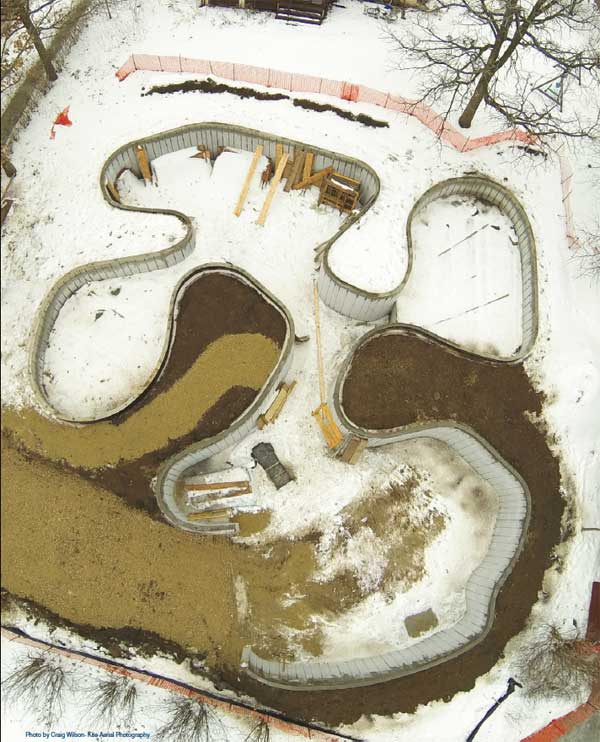
Taken by kite photography, this foundation could not have been photographed by any ground-based physical means, and drones were not yet providing high-resolution images. Photo courtesy of Hottmann Construction, Madison, Wisconsin.
A kite is not subject to the restrictions imposed on planes, helicopters or even drones. Wilson can fly his camera directly over a crowded stadium, within feet of the tops of buildings, or just above the heads of people enjoying lunch at a café. He celebrates the fact that time is not so much of an issue with kite photography. There are no expensive rental fees and battery life is not a concern. An airplane cannot practically hang around all afternoon to wait for the perfect light or site conditions.
Wilson was brought in to feature the construction of a home built into a 100-year-old neighborhood where access was nearly impossible due to the closeness of surrounding property lines. Not only was it successful, but also it was the best way to tell the incredible story of this foundation construction.
Whether you prefer the high-tech drone or the nostalgia of a kite, one thing is certain: the versatility and flexibility afforded by these options is of great value in telling the story of your projects and conveying the craftsmanship, artistry and perhaps even a bit of the insanity of the work you produce.










Happy to read about the history of the ariel photography and the importance of drone with it. Great shots and wonderful explanation. Enjoyed learning about drones from this post. Thank you for sharing.